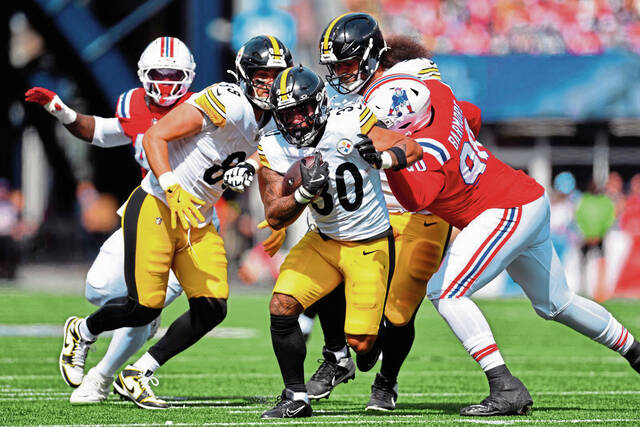https://triblive.com/sports/steelers-4-downs-jaylen-warren-among-nfls-toughest-to-tackle/
Steelers 4 Downs: Jaylen Warren among NFL’s toughest to tackle

1. Tough to tackle
The Pittsburgh Steelers’ Jaylen Warren ranks only 21st in the NFL in rushing yards. But there are some metrics that suggest he’s among one of the best running backs in the NFL.
According to pro-football-reference.com, Warren’s 2.7 yards after contact per attempt ranks fourth in the league. In conjunction with that — and to illustrate how much Warren has created yardage on his own this season — only two of 48 qualifying NFL ball-carriers are hit earlier in carries on average than Warren. He averages just 1.5 yards per carry before contact.
Warren also ranks second in the league in rate of forcing broken tackles. Warren is credited with breaking a tackle once every 7.1 carries. For context, the NFL average is 15.0.
Pro Football Focus also has a favorable view of Warren’s production. It credits him with 27 missed tackles forced this season, meaning he has avoided a tackle on 23.8% of his carries, a figure that compares favorably against the season’s rushing yardage leaders. Warren also ranks fourth in the NFL in PFF’s “elusive rating,” which the outlet defines as “measuring success and impact of a runner with the ball independently of the blocking.”
Incidentally, Warren also is one of the NFL’s best pass-catching running backs as evidenced by his No. 3 ranking among his position in receiving yards gained per route run (1.84).
2. Equal opportunity
Brandin Echols, by most measures objective or subjective, had his worst game as a Steeler last week. The highest-profile plays against him were by Ladd McConkey, who had the Chargers’ longest four gains of the game via his catches, three of which, according to Pro Football Focus, were with Echols the closest defender in coverage. That includes a 58-yard reception in the fourth quarter and a 15-yard touchdown in the first half.
It wasn’t just McConkey, though, who beat Echols (at least if PFF charting is to be believed). Echols was the closest man in coverage for five different Chargers pass-catchers in their win against the Steelers: McConkey, Quentin Johnston, Keenan Allen, Tre Harris and running back Kimani Vidal. In all, when a player Echols had in coverage was targeted Sunday, Justin Herbert went 8 for 9 for 125 yards and a touchdown for a near-perfect 155.8 passer rating.
Through the first six games of the season, quarterbacks targeting an Echols-guarded receiver had a 70.8 passer rating. In the three games since, that figure balloons to 108.2.
3. WRs 1 way, TEs the other
Judging by what happened when the Steelers played the Cincinnati Bengals four weeks ago, it should come as no surprise that the Steelers have some of the NFL’s worst defensive statistics against opposing wide receivers, and the Bengals have even worse numbers against tight ends.
In that Oct. 16 game at Paycor Stadium, Steelers tight ends combined for four touchdown receptions. Bengals wide receivers combined for 25 receptions.
That game alone probably inflates their respective season statistics. Regardless, for the season, no team has allowed more WR catches than the Steelers. By far. Opposing wide receivers have 143 receptions against the Steelers. The only teams within even 17 such receptions all have played 10 games while the Steelers have played nine. The Indianapolis Colts have allowed the second-most WR catches (135) but have played an additional game.
At 194.1 per game, no team allows more yardage to wide receivers than the Steelers, either.
Cincinnati, meanwhile, has allowed 12 opponent tight end touchdowns this season. No other team has allowed more than seven. The Bengals allow a league-most 80.2 receiving yards per game to tight ends.
4. Safety valves
In relaying his decision to keep his new safety tandem together, Steelers coach Mike Tomlin mentioned that, “We’re making people earn it more.”
What Tomlin was referring to was a reduction in explosive plays allowed. He wasn’t wrong.
Since the Steelers re-did their safeties corps two weeks ago by moving Jalen Ramsey to the position and trading for veteran Kyle Dugger, opponents have combined for just three plays of at least 25 yards in two games. In each of the two prior Steelers games, opponents had six and four gains, respectively, of at least 25 yards.
Copyright ©2025— Trib Total Media, LLC (TribLIVE.com)
